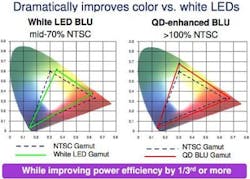European Commission asserts environmental benefit of cadmium-based quantum dots
The European Commission has granted an exemption to the Restriction of Hazardous Substances (RoHS 2) Directive for Electrical and Electronic Equipment (EEE), according to QD Vision (Lexington, MA). The ruling confirms that QD Vision's wide-color-gamut quantum-dot technology for displays is beneficial for the environment, says the company.
QD Vision makes green and red quantum dots that, when used in displays with a blue LED excitation source, lead to colors with higher saturation than produced by ordinary liquid-crystal displays (LCDs). QD Vision is even developing IR quantum dots for the U.S. military. QD Vision's quantum dots are based on cadmium-containing semiconductors; because cadmium itself is toxic, the company has taken pains to 1) ensure the manufacturing process and resulting devices are safe, 2) make sure the public knows this, and 3) publicize the fact that quantum dots reduce display energy use. (In addition, the amount of cadmium in a quantum-dote display is minuscule and the cadmium is well sealed in the device.)
The European Commission's statement
As stated in the official European Commission Delegated Directive, "Colour converting LEDs using quantum dots have significant advantages regarding energy efficiency and colour performance. Quantum dots are already used in displays and are likely to be introduced in illumination applications in the coming years. The use of quantum dots in displays has a positive overall impact due to their low energy consumption. The use of cadmium in downshifting cadmium based semiconductor nanocrystal quantum dots for use in display lighting applications should therefore be exempted from the prohibition until 30 June 2018."
"This EU decision clears the way for QD Vision to strengthen their position in a market we estimate to grow to over $10.6 billion by 2025," says Jennifer Colegrove, CEO and principal analyst at Touch Display Research (Santa Clara, CA; www.touchdisplayresearch.com). Touch Display Research recently published its second edition of the Quantum Dot Display and Lighting Technologies and Market Forecast Report.
Source: QD Vision

John Wallace | Senior Technical Editor (1998-2022)
John Wallace was with Laser Focus World for nearly 25 years, retiring in late June 2022. He obtained a bachelor's degree in mechanical engineering and physics at Rutgers University and a master's in optical engineering at the University of Rochester. Before becoming an editor, John worked as an engineer at RCA, Exxon, Eastman Kodak, and GCA Corporation.
